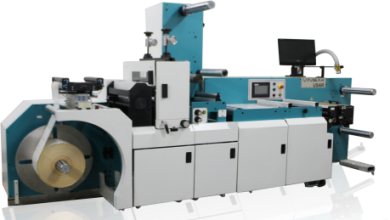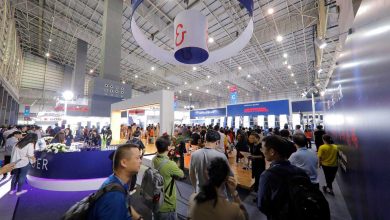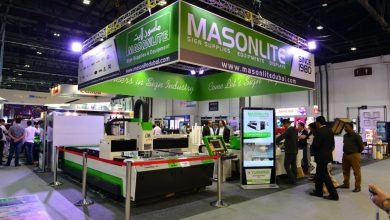SGI 2015 Wraps Up
Another electrifying edition of Sign and Graphic Imaging Exhibition 2015 has been ended. Who can believe that it is already the 18th edition? Well, us who have witnessed most of the past exhibitions even cannot believe it. The show has matured from a marginal note in the international trade show calendar to a truly international event that draws visitors from near and far away.
18 years old – in many countries this means that you have developed yourself and are considered an adult. And yes, once again, SGI Dubai 2015 has grown up. It now features not only the exhibition but also a special textile printing area, a seminar series, the Signage Middle East Conference 2015, and, of course the Signage Middle East Awards 2015.
 The date of the exhibition once again has been the subject of discussion. Obviously the first half of January is holiday season especially in Europe. However it seemed that the seasonal break didn’t deter top executives from Europe and elsewhere to travel to Dubai. ME Printer also managed to have one on one interviews with some of them including CEO of Durst and Agfa’s top authority for Inkjet.
The date of the exhibition once again has been the subject of discussion. Obviously the first half of January is holiday season especially in Europe. However it seemed that the seasonal break didn’t deter top executives from Europe and elsewhere to travel to Dubai. ME Printer also managed to have one on one interviews with some of them including CEO of Durst and Agfa’s top authority for Inkjet.
This year almost all the exhibitors we talked to were happy about the attendance and the quality of the visitors. Many including HP have already booked their stand for year 2016.
This year IEC has introduced new segments such as ShopME and the textile pavilion to highlight the emerging market trends in the world of signage and LFP market. One of most interesting aspects of SGI is the diversity of its visitors. People and decision makers from CIS countries, Iran, GCC and African counties travelled to Dubai to attend the show.
Exhibitors’ take on SGI
Almost all the exhibitors we had the opportunity to talk to were happy with the show. A few who told us that the exhibition didn’t meet their expectation insisted that SGI is the most important regional show for them anyhow. And they will come back next year. Abdallah Aoude from HP is upbeat about the show. “This year we met with real customers who knew exactly what they want. The fact is people now believe if they visit the show they get a better deal. That is a good sign and a positive development for this show. We met serious buyers from KSA, Qatar, UAE, Bahrain and Oman.
Printers now have genuine concern about environment and they ask for specific application such as printing wall papers for example. They now understand the benefit of water based products and willing to buy it. Comparing to last exhibition there were less visitors from Africa. Our L 3000 has been very popular. Recently we have sold a number of machine including one to Traffic Media and another one to a printer to Oman. There is also huge demand for our flatbed machines.” Comments Aoude.
Copatra Graphics, headquarted in Jeddah (KSA) with branches in Riyadh and Dammam and active across the GCC region as well as neighbouring countries, has been in the graphic communications business for over four decades and now has completed its first decade of successful partnership with SGI Dubai.
The companies celebrated those 10 years at the first day of SGI.
Copatra distributes the range of Eco- mild and solvent wide format printers and plotters as well as textile printers from DGI.
And there was more reason to celebrate for Copatra: The roll-fed DGI VE320D that Copatra brought to the show was purchased by Derer trading company from Jeddah (KSA) where the four colour printer will be added to the existing fleet of printers. It accommodates media up to 3.2 m width and features four printheads for four-color printing (CMYK) with a resolution of up to 720x720dpi. Alternatively the printer enables printing on two smaller rolls or one 3.2m wide substrate roll. The machine is driven by the Wasatch RIP.
The Korean printer manufacturer DGI will celebrate 30 years since its inauguration in May this year.
In addition, the Copalaser engraving device, a new addition to the Copatra product line that is exhibited by the company for the first time at SGI also went to a Saudi Arabian company from Makkah that will use it for engraving for advertising.
Copatra also could record another sale: The Anapurna M2500 on show, a 2.5 m wide inkjet printer featuring speeds of up to 60sqm/h, was purchased by Noor al Ebdaa from Riyadh (KSA). The seven-colour printer (CMYKLcLm+W) prints with UV curable inks and features Konica Minolta printheads.
eWorks who was exhibiting through one of its re sellers ColourByte introduced an ERP (Enterprise Resource Planning) solution for SMEs. An End-to-End Workflow System. What’s interesting about this software is that it’s made here in Dubai. According to the company working with the system is as simple as click and drag. System’s core engine is FileMaker (www.filemaker.com), a wholly owned subsidiary of Apple Computer Inc. It is refreshing to see that local companies are introducing state-of-the-art products to the market.
But SGI was also a hit for printers such as Ndigitec as well. According to Sai Naveen Company’s marketing manager the event drew potential and existing clients to the exhibition, making it a successful exhibition for Ndigitec.
He said. ” We would urge the organizers to promote the exhibition extensively in the future which would benefit all the stakeholders involved. NDIGITEC exhibited the entire range of solutions we offer and particularly promoted D-Board, CGI, 3D Printing and our latest venture Dubaiprint.com at SGI 2015.
We have received an overwhelming response to our D-Board range of solutions as it is a versatile solution for all exhibition stand and display needs.
Web-to-print technologies excite us hence invested in our own platform, Dubaiprint.com in 2014.
The industry is doing well but we should focus on delivering quality products and services rather than wasting time by engaging in price wars in the market. Participation in shows such as SGI is good but exhibiting is only 10% of the job done, the remaining 90% work needs to be done post exhibition; in terms of converting leads gathered at the exhibition to customers.
We also believe social media platforms play a big role in building a brand presence which leads to profitable sales in the long run.”
Textile Printing coming of Age
Number of textile printers launched at the show was impressive. However digital textile printing is still at its infancy and printers need to learn and master the technology. Maria Renee Ayau from Flaar Reports who attended the show to report on textile printers has some useful tips for printers who want to enter this lucrative market.
Direct-to-fabric textile printing can be achieved by using four different kinds of inks: acid, reactive, disperse dyes and pigment inks.
Pigment ink is mostly used to print onto cotton and cotton-blended fabrics and cannot be absorbed by the fabrics, they adhere to the surface but do not penetrate it. Pigment is a kind of insoluble colorant, ground into fine powders and added to a liquid carrier.
For the past decade everyone commented how uninspiring the colour of pigmented textile ink was. This was one of the main issues with pigment ink that the colours were not quite as bright and intense as compared with the results of other printing methods. The only reason people used it was to avoid all the pre-printing workflow and post-printing washing, drying, etc. But every year the colour has gotten a bit better. At drupa 2012 I overheard experienced textile manager from Europe comment on how pleasantly surprised he was to see the remarkable quality of the new pigment ink from Hongsam.
A few years ago, I noticed that Hongsam’s pigment ink produced more intense and brighter colours than the rest of the other brands. Pigment ink in general is characterized for not producing the brightest colours compared to other kinds of textile inks. At SGIA in Las Vegas DigiFab introduced new inks also with an improved colour. Now a Fortune 500 company has also released a new pigmented ink, so it’s crucial to learn about all this before your competitors do. So attending the first international signage and printer expo of the year (SGI) is a good idea.
The main problem is the limitation of the amount of pigments the binder can use without clogging the printer’s printheads. Which results in less saturated colours and less wash fastness compared to other inks types.
Be aware that every brand of printer has a slightly different ink delivery system inside it. Plus each printer has different firmware. And print shops use different RIP software. So it is to be expected that an ink will function a tad differently in a really wide-format printer than in a cheaper desktop printer. Plus the temperature, humidity, and dust content of your print shop (and the type of fabric) will affect whether the printheads clog or not.
Nonetheless a pigmented ink in theory works both on wide-format printers and desktop sized T-shirt printers. The ink comes in four colours (cyan, magenta, yellow, black) for wide-format printers and five colours (CMYK + white) for desktop printers.
Kornit has uses pigment ink on its t-shirt and wide-format printers and the results are absolutely beautiful. The colour pop is so impressive people stop and see, because it is hard to believe such results can be accomplished by using pigment inks. So the technology keeps moving forward and many ink manufacturers are working on developing improved versions of their pigment inks. So here at SGI 2015, be sure to ask about improved pigmented ink for textiles.
T-shirt printing using pigment ink requires a coat of pre-treatment on the fabric. First the pre-treatment is sprayed directly into the fabric and afterwards the fabric is set to dry by using a heat press to accelerate the process.
When using a T-shirt with a white background, you print using only CMYK inks. On the other hand if you print onto a T-shirt with a dark background you need to print a silhouette of white ink (primer) and then you print using CMYK on top of the primer.
After printing, you need to fix the colour using a heat press, to avoid ink form peeling or scratching.
Whether you use a heat press or a more sophisticated heat curing process will influence how the colour comes out (on your T-shirt or other application). A heat press is made for sublimation ink. People use it for pigmented ink (and toner-based ink T-shirt transfers also). But you may get better results using a curing system made specifically for pigmented ink.
Our take away
According to the figures provided by IEC, organizer of the show 12,781 visitors not only from the MENA region but worldwide visited the event.
SGI is an important event in the international trade show calendar. It influences printer’s decisions on buying new equipment and/or entering new business activities. The multitude of applications that are enabled by large format printing are mind boggling by now. The list keeps growing from formerly printing only on paper, then textiles, to glass, wood and ceramics. For those who are willing to learn about the signage industry SGI has always been and will be an ideal place.
But that’s not all, SGI is the place that helps you meet the right specialist and find the right equipment. There are many hidden gems on the exhibition floor including small printers that can print on all kinds of difficult surfaces and utensils as well as special media that offers printers that extra edge that is required in today’s competitive market environment.
SGI 2015 had all the ingredients of a world class trade event. Also it seems that the region is once again on the rebound. The positive mood is reflected in the words of Abdul Rahman Falaknaz, Chairman of IEC: “Confidence has returned to the region in a big way post Dubai’s Expo 2020 win and we can see the development happening around us at a breakneck speed. The demand within the printing and signage industry has grown tremendously and I am sure the stakeholders in this industry have experienced this growth since the last few years.”
 Signage Middle East Awards 2015
Signage Middle East Awards 2015
Honours from the Signage Middle East Awards last night that recognize excellence in business leadership through investment in signage innovation, execution, and creativity: http://meprinter.com/news/4690/




